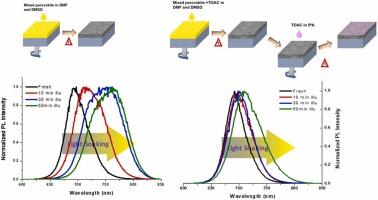四辛基氯化铵抑制混合卤化物钙钛矿太阳能电池光致相分离的协同效应
IF 6.3
2区 材料科学
Q2 CHEMISTRY, PHYSICAL
引用次数: 0
摘要
由卤化物离子在光照下迁移引起的相偏析是限制混合卤化物钙钛矿商业化的关键挑战。在本研究中,首次采用四烷基氯化铵(TOAC)作为添加剂和表面钝化,提出了一种简单有效的策略来减轻FA0.83Cs0.17Pb(I0.6Br0.4)3混合卤化物钙钛矿膜的光致相偏析。结果表明,TOAC有效地减少了卤化物离子迁移,稳定了钙钛矿相,抑制了相偏析,特别是在添加剂-钝化组合结构中。采用这种双TOAC方法制备的混合卤化物钙钛矿太阳能电池的效率最高,达到15.8%,并且在连续照明下增强了稳定性,减少了滞后。该研究强调了TOAC在抑制相偏析,改善混合卤化物钙钛矿太阳能电池的稳定性和性能方面的关键作用,通过解决表面和体积缺陷,促进了更稳定和高效的混合卤化物钙钛矿太阳能电池的发展。本文章由计算机程序翻译,如有差异,请以英文原文为准。

Synergetic effect of tetraoctylammonium chloride in suppressing photoinduced phase segregation in mixed halide perovskite solar cells
Phase segregation, caused by halide ion migration under illumination, is a critical challenge limiting the commercialization of mixed-halide perovskites. In this study, a facile and effective strategy is introduced to mitigate photoinduced phase segregation in the FA0.83Cs0.17Pb(I0.6Br0.4)3 mixed halide perovskite film by employing tetraoctylammonium chloride (TOAC) as both an additive and surface passivation for the first time. The results demonstrate that TOAC effectively reduces halide ion migration, stabilizes the perovskite phase, and suppresses phase segregation, particularly in the combined additive-passivation configuration. Mixed-halide perovskite solar cells fabricated with this dual TOAC approach achieve the highest efficiency of 15.8 %, with enhanced stability under continuous illumination and reduced hysteresis. The study highlights the critical role of TOAC in suppressing phase segregation, and improving the stability and performance of mixed-halide perovskite solar cells by addressing both surface and bulk defects, facilitating the development of more stable and efficient mixed-halide perovskite solar cells.
求助全文
通过发布文献求助,成功后即可免费获取论文全文。
去求助
来源期刊

Journal of Alloys and Compounds
工程技术-材料科学:综合
CiteScore
11.10
自引率
14.50%
发文量
5146
审稿时长
67 days
期刊介绍:
The Journal of Alloys and Compounds is intended to serve as an international medium for the publication of work on solid materials comprising compounds as well as alloys. Its great strength lies in the diversity of discipline which it encompasses, drawing together results from materials science, solid-state chemistry and physics.
 求助内容:
求助内容: 应助结果提醒方式:
应助结果提醒方式:


